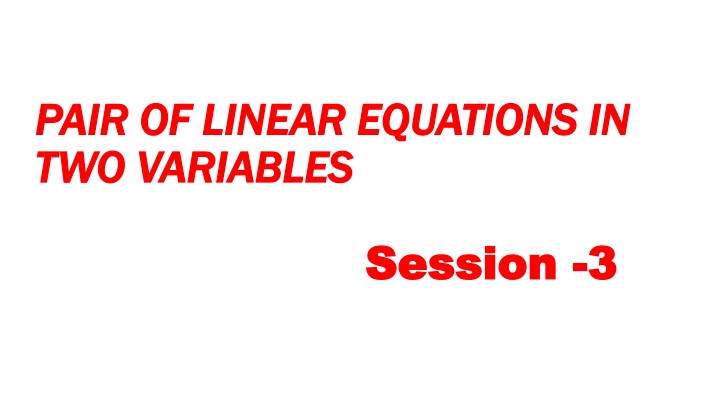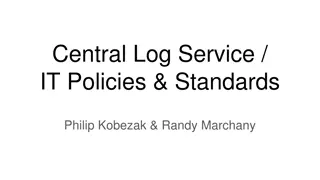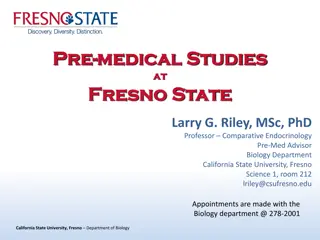
Linear Equations in Two Variables: Substitution Method & Word Problems
Learn how to solve pairs of linear equations using the substitution method and apply it to real-world word problems. Explore step-by-step solutions and understand the concepts with examples.
Download Presentation

Please find below an Image/Link to download the presentation.
The content on the website is provided AS IS for your information and personal use only. It may not be sold, licensed, or shared on other websites without obtaining consent from the author. If you encounter any issues during the download, it is possible that the publisher has removed the file from their server.
You are allowed to download the files provided on this website for personal or commercial use, subject to the condition that they are used lawfully. All files are the property of their respective owners.
The content on the website is provided AS IS for your information and personal use only. It may not be sold, licensed, or shared on other websites without obtaining consent from the author.
E N D
Presentation Transcript
PAIR OF LINEAR EQUATIONS IN PAIR OF LINEAR EQUATIONS IN TWO VARIABLES TWO VARIABLES Session Session - -3 3
SUBSTITUTION METHOD SUBSTITUTION METHOD Dear students, so far we have learnt how to solve a given system of equations graphically. However, there are 3 different methods to solve a pair of linear equations algebraically. The first and the simplest method of them all is substitution method. As the name suggests, in order to find the value of one variable , we substitute it terms of the other. This video will further help you understand the method.
Let us now begin with the next exercise. Ex 3.3 Q1. Solve the following pair of linear equations by the substitution method. Solution: 2 x + 3 y = 0 -------------(1) 3 x + 8 y = 0 -------------(2) We can rewrite (1) as 2 x = - 3 y 3 2y --------------------------------------(3) Substituting the value of x from (3) in (2), we get - 2y + 8 y =0 i.e. 3+4 2 i.e. y=0 Substituting the value of y in (3), we get x=0. Thus, x=0, y=0 is the required solution. i.e. x= - 3 y=0, i.e. 1 2y=0
Note: Complete the rest of the parts of Q1 of Ex 3.3 on your own in your notebook. Now, let us take up question 2 from Ex 3.3 Q2. Solve 2x + 3y = 11 and 2x 4y = 24 and hence find the value of m for which y = mx + 3. Solution: 2x + 3y = 11--------(1) 2x 4y = 24-------(2) (1) Can be re-written as, x= 11 3? 2 --------(3) Substituting the value of x in (2) we get, 11-3y-4y= -24 i.e. 35=7y i.e. y=5. Substituting the value of y in (3) we get x= -2. Thus, the substituting the value of x and y in the equation y=mx+3, we get m=-1
Let us now solve some of the word problems algebraically. Q3. (iv) The taxi charges in a city consist of a fixed charge together with the charge for the distance covered. For a distance of 10 km, the charge paid is 105 and for a journey of 15 km, the charge paid is 155. What are the fixed charges and the charge per km? How much does a person have to pay for travelling a distance of 25 km? Solution: Let the fixed charge be x and the charge per km be y. Then, according to the question, x+10y= 105-------(1) and x+15 y= 155----------(2) (1) Can be re-written as x=105-10y--------(3) Substituting the value of x from (3) in (2) we get, 105 -10y +15y= 155 i.e. 5y=50, i.e. y=10 Using the value of y in (3), we get x= 5. Thus, the fixed charge is 5 and the charge per km is 10. So, the total charge for travelling a distance of 25 km is (x+25y)= 255
Q3. (v) A fraction becomes 9 /11 , if 2 is added to both the numerator and the denominator. If, 3 is added to both the numerator and the denominator it becomes 5/ 6 . Find the fraction. Solution: Let the numerator be x and the denominator be y. Then, the required fraction is ? ?. According to the question, ?+2 And ?+3 6i.e. 6x+18= 5y+15, i.e. 6x-5y= - 3-----------(2) Again , (1) can be re-written as x= 9? 4 Substituting (3) in (2) we get, 54? 24 9 ?+2= 11i.e. 11x +22= 9y+18 i.e. 11x - 9y = - 4--------(1) ?+3= 5 11-----------(3) -5y= -3 11 i.e. 54y -24 -55y =-33, i.e. y= 9. Substituting the value of y in (3), we get, x=7. Thus, the required fraction is 7 9.
Q3. (v) Five years hence, the age of Jacob will be three times that of his son. Five years ago, Jacob s age was seven times that of his son. What are their present ages? Solution: Let the present age of Jacob be x years and present age of his son be y years. Then , Jacob s age five years hence would be (x+5) years and his age five years ago was (x-5) years. Similarly, his son s age five years hence would be (y+5) years and his age five years ago was (y-5) years. According to the question, x+5 = 3(y+5) i.e. x+5= 3y+15 , i.e. x-3y = 10-----------(1) And x-5= 7(y-5), i.e. x -5 = 7y- 35, i.e. x-7y = -30------------(2) (1) can be re- written as x= 10+3y------------------(3) Substituting (3)in (2) we get, 10+3y-7y= -30, i.e. y= 10. Substituting the value of y in (2) we get, x= 40. Thus, Jacob s age= 40 years and His son s age = 10 years.
NOTE: Kindly note that as you solve a word problem, It should always end with a concluding statement. For example, the concluding statement in the last problem was Thus, Jacob s age = 40 years and His son s age = 10 years. If you miss on writing the same you might lose marks. Now , complete the rest of the parts of Q3 in your notebook.
PRACTICE QUESTIONS FROM ASSIGNMENT 1. A and B are friends and their ages differ by 2 years. A s father D is twice as old as A and B is twice as old as his sister C. The age of D and C differ by 40 years. Find the ages of A and B. 2. Given a linear equation 3x 5y = 11, form another linear equation such that the geometric representation of the pair formed is [CBSE 2015] (a) Intersecting lines (b) Co incident lines and (c) Parallel lines 3. Find the value of a such that the point (3,a) lies on the line 2x 3y = 5 4. Find the value of x and y for the given rectangle: 5. Raju buys 7 books and 6 pens for 2750 and Anand buys 3 books and 5 pens of the same kind for 1300. What are the respective costs of the book and the pen? [NSTSE 2019]






